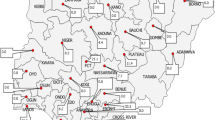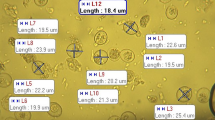Abstract
Coccidiosis is an important disease in the poultry industry caused by species of protozoan parasites belonging to the genus Eimeria (phylum Apicomplexa); it results in a great economic loss all over the world. The aim of this study was to determine the frequency and diversity of Eimeria species, the effect of season on the prevalence of coccidiosis in poultry, and the evaluation of its histopathological changes in native infected chickens in different parts of Sistan. A total of 2792 samples selected through random cluster sampling of chickens from areas of Sistan (Zabol, Hirmand, Nimrooz, and Zehak) and their infected organs especially intestines were examined for histopathological studies. Out of the 2792 samples processed, 585 samples were found to be positive for coccidiosis with a prevalence of 20.95%. Coccidiosis was initially diagnosed on the basis of fecal examination and confirmed by the presence of sporulated oocysts and pathomorphological alterations in the intestines. Five Eimeria species identified by morphometry were Eimeria acervulina, E. maxima, E. brunetti, E. necatrix, and E. tenella. Based on the results of the experiments, the percentage of coccidiosis infection in cold seasons (October–March) was higher than in the warm seasons (April–September). Histopathological lesions revealed loss of epithelial tissue, congestion of blood vessels which indicate disruption followed by hemorrhage, severe muscular edema, and necrosis of the submucosa of the intestine and cecum. There was loss of intestinal villi, disruption of cecal mucosa, and clusters of oocysts seen. Also, there was massive infiltration by a large number of inflammatory cells including eosinophil, lymphocyte, and plasma cells. Several merozoites, schizonts, microgametes, and macrogametes were found in the epithelial cells.


Similar content being viewed by others
References
Ahad S, Tanveer S, Malik TA (2015) Seasonal impact on the prevalence of coccidian infection in broiler chicks across poultry farms in the Kashmir valley. J Parasit Dis 39(4):736–740
Dinka A, Tolossa YH (2012) Coccidiosis in Fayoumi Chickens at Debre Zeit Agricultural Research Center Poultry Farm, Ethiopia. Eur J Appl Sci 4:191–195
Chapman HD (2009) A landmark contribution to poultry science prophylactic control of coccidiosis in poultry. Poult Sci 88:813–815
Davari H, Nematollahi (2004) Investigating the contamination of Eimeria species in poultry in Tabriz, Dissertation for a Ph.D. in Veterinary Medicine, Faculty of Veterinary Medicine, Islamic Azad University of Tabriz, pp. 56–58
Eslami A, Ranjbar-Bahadori P (2005) Laboratory methods for diagnosis of communicative diseases, veterinary. ISBN Publication, Azad University, Garmsar Branch, 1st edn, pp. 62–63
Eslami A, Ghaemi P, Rahbari S (2009) Parasitic infections of free–range chickens from Golestan Province, Iran. Iran J Parasitol 4(3):10–14
Gharekhani J, Sadeghi-Dehkordi Z, Bahrami M (2014) Prevalence of coccidiosis in broiler chicken farms in Western Iran. J Vet Med 2014, Article ID 980604, 4 pages
Graat EAM, Ploeger HW, Henken AM, De Vries Reilingh G, Noordhuizen JPTM, Van Beek PNGM (1996) Effects of initial litter contamination level with Eimeria acervulina on population dynamics and production characteristics in broilers. Vet Parasitol 65(3-4):223–232
Hendrix CM (1998) Diagnostic veterinary medicine, 2nd edn. Mosby Publishers, St. Louis, pp 249–255 257-259
Jadhav BN, Nikam SV, Bhamre SN, Jaid EL (2011) Study of Eimeria necatrix in broiler chicken from Aurangabad district of Maharashtra state India. Intern Multidis Res J 1:11–12
Jahantigh M, Salehi M (2012) Poultry diseases and its control, 1st edn. ISBN Publication, Bahar, Tehran, pp 451–465
Khan MQ, Irshad H, Anjum R, Jahangir M, Nasir U (2006) Eimeriosis in poultry of Rawalpindi/Islamabad area. Pak Vet J 26:85–87
Luna LG (1968) Manual of histological staining methods of the armed registry of pathology, 3rd edn. Mc Graw Hill, New York, pp 36–95
Matter F, Oester H (1989) Hygiene and welfare implications of alternative husbandry systems for laying hens. In: Faure JM, Mills D (eds) Proceedings from the 3rd European symposium on poultry welfare. Tours, France, p 201–212
McDougald LR, Reid WM (1997) Coccidiosis. In: Calnek BW, Barnes HJ, Beard CW, McDougald LR, Saif YM (eds) Diseases of poultry. Iowa State University Press, Ames, pp 865–883
Mehrabi M, Yakhchali M (2015) Study of the frequency and diversity of Eimeria species in broiler chickens in Hamedan. J Vet Res 69(2):111–117
Meireles MV, Roberto LO, Riera RF (2004) Indentification of Eimeria mitis and Eimeria praecox in broiler feces using polymerase chain reaction. Braz J Poult Sci 2:728–727
Muazu A, Masdooq AA, Ngbede J, Salihu AE, Haruna G, Habu AK, Sati MN, Jamilu H (2008) Prevalence and Identification of Species of Eimeria Causing Coccidiosis in Poultry Within Vom, Plateau State, Nigeria. Int J Poult Sci 7(9):917–918
Nematollahi A, Moghaddam Gh, Pourabad RF (2009) Prevalence of Eimeria species among broiler chicks in Tabriz (Northwestern of Iran). Munis Entomol Zool 2
Rahbari S, Adib Hesami H (1995) Evaluation of oocyst counts in control of poultry coccidiosis. Pajouhesh va Sazandegi 72:027–021. (In Persian)
Rasheda M, Bano L (1985) Histopathology of coccidiosis by Eimeria garnhami in coturnix coturnix of N.W.F.P. Pak Vet J 1:27–29
Razmi GR, Kalideri AG (2000) Prevalence of subclinical coccidiosis in broiler-chicken farms in the municipality of Mashhad, Khorasan, Iran. Prev Vet Med 44(3–4):247–253
Sharma S, Iqbal A, Azmi S, Mushtaq I, Wani ZA, Ahmad S (2015) Prevalence of poultry coccidiosis in Jammu region of Jammu & Kashmir State. J Parasit Dis 39(1):85–89. https://doi.org/10.1007/s12639-013-0286-5
Sood S, Yadav A, Vohra S, Katoch R, Ahmad BD, Borkatari S (2009) Prevalence of coccidiosis in poultry birds in R.S.Pura region, Jammu. Vet Pract 10(1):69–70
Soomro NM, Rind R, Arijo AG, Soomro SA (2001) Clinical, gross and histopathological studies of coccidial infection in chicken. Int J Agric Biol 3(4):426–427
Soulsby EJL (1986) Helminths, arthropods and protozoa of domesticated animals, 8th edn. Aca Press, London, pp 630–639
Sureshkumar V, Venkateswaran KV, Jayasundar S (2004) Interaction between enrofloxacin and monensin in broiler chickens. Vet Hum Toxicol 46(5):242–245
Yakhchali M, Fakhri M (2017) Prevalence of Eimeria species in free-range chickens of villages of Khoy suburbs, Iran.Vet Res Biol Prod (PAJOUHESH-VA-SAZANDEGI) 30 1(114):205–211
Yakhchali M, Fakhri M (2018) Frequency of Eimeria species infection in native poultry villages surrounding Khoy city in West Azerbaijan Province. Vet J, Research & Production Number 114
Acknowledgments
This work has been supported by the Faculty of Veterinary Medicine of Zabol University, and the authors wish to express their deep sincere to Mrs. Rashki laboratory technician staff at the Faculty of Veterinary and habitants of Zabol, Hirmand, Adimi, and Zahak regions.
Author information
Authors and Affiliations
Corresponding author
Ethics declarations
Conflict of interest
The authors declare that they have no conflict of interest.
Ethical approval
Ethical approval for the present study was duly obtained from and approved by the Institutional Animal ethics and Research committee of the Faculty of Veterinary Medicine, University of Zabol, Iran.
Rights and permissions
About this article
Cite this article
Shahraki, F., Shariati-Sharifi, F., Nabavi, R. et al. Coccidiosis in Sistan: the prevalence of Eimeria species in native chicken and its histopathological changes. Comp Clin Pathol 27, 1537–1543 (2018). https://doi.org/10.1007/s00580-018-2770-x
Received:
Accepted:
Published:
Issue Date:
DOI: https://doi.org/10.1007/s00580-018-2770-x




